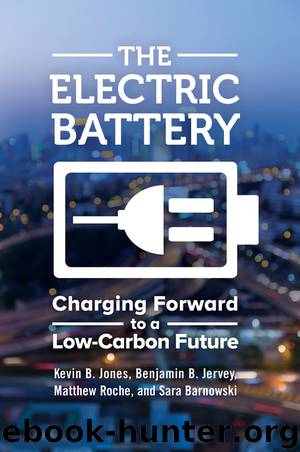The Electric Battery: Charging Forward to a Low-Carbon Future by Jones Kevin B.; Jervey Benjamin B.; Roche Matthew

Author:Jones, Kevin B.; Jervey, Benjamin B.; Roche, Matthew
Language: eng
Format: epub
Publisher: ABC-CLIO, LLC
Storage as a Backup Energy Resource
As dynamic pricing and demand charge revenue opportunities support a stronger business case for home and office battery storage, customers will also increasingly be attracted to batteries for their use as a backup energy resource. Today, batteries play an important supplemental power role on a daily basis for off-grid electric uses. The lead acid battery has proven to be a reliable and cost-effective choice for customers who do not have convenient access to an existing electric grid. For off-grid systems, battery storage provides sufficient stored energy to allow energy-conscious consumers to provide modern conveniences. In states with net metering programs, solar customers who do not face expensive line extension bills in order to be tied to the grid, usually find that using the grid as their “battery”—to both take excess generation from the solar system and provide supplemental power when there isn’t sufficient sun—is the most cost-effective alternative. Thus, including backup battery storage with grid-tied systems has not recently been either cost effective or popular.
The challenge with the battery is the limited total energy available to the home or office prior to a lengthy recharge. For example, one 7-kWh Tesla Powerwall unit would provide only from two to eight hours of backup power for an average home (Tesla removed all references to its 10-kWh battery from its Web site soon after introduction and instead is relying on its 7-kWh battery, which is better optimized for daily consumption rather than backup storage). Furthermore, the Powerwall is only rated for 2 kW of continuous use, and while that will likely power the household lights, refrigerator, Internet, and television for a few hours, it is not designed to power major appliances at the same time. Your air conditioner (1.5 kW), electric range (1.2–2.1 kW), microwave (1.3 kW), toaster (1.5 kW), electric heat pump (2.5 kW), or electric clothes dryer (5.4 kW) would overpower its capacity or drain its battery more quickly.29 While multiple batteries can be stacked to provide additional power, this option very quickly becomes cost prohibitive. According to analysis by Goldman Sachs, the cost of a Tesla Powerwall unit sized to provide 48 hours of backup power would be over three times as much as a conventional diesel generator. A home or office battery performing bill management services can provide some backup power, but electric batteries still face financial barriers as reliable sources of backup power, particularly when compared to the cost and performance of home generators.30 According to Greentech Media, a 2016 survey by Enphase (a microinverter company) of 566 homeowners in California, Hawaii, Massachusetts, and New York who have or are looking to get solar systems found some interesting results. While 20 percent of these homeowners already had a backup generator, of the remaining households, 50 percent said they were interested in a backup generator. When probed further, these respondents both wanted multiple days of backup power and wanted to pay less than $10,000, posing a service and cost challenge for existing battery companies.31
Download
This site does not store any files on its server. We only index and link to content provided by other sites. Please contact the content providers to delete copyright contents if any and email us, we'll remove relevant links or contents immediately.
| Alternative & Renewable | Drilling Procedures |
| Electric | Fossil Fuels |
| Mining | Nuclear |
| Power Systems |
Whiskies Galore by Ian Buxton(40330)
Introduction to Aircraft Design (Cambridge Aerospace Series) by John P. Fielding(32338)
Small Unmanned Fixed-wing Aircraft Design by Andrew J. Keane Andras Sobester James P. Scanlan & András Sóbester & James P. Scanlan(32141)
Craft Beer for the Homebrewer by Michael Agnew(17446)
Turbulence by E. J. Noyes(7039)
The Complete Stick Figure Physics Tutorials by Allen Sarah(6638)
Kaplan MCAT General Chemistry Review by Kaplan(6053)
The Thirst by Nesbo Jo(5785)
Bad Blood by John Carreyrou(5769)
Learning SQL by Alan Beaulieu(5411)
Weapons of Math Destruction by Cathy O'Neil(5036)
Man-made Catastrophes and Risk Information Concealment by Dmitry Chernov & Didier Sornette(4735)
iGen by Jean M. Twenge(4702)
Digital Minimalism by Cal Newport;(4540)
Life 3.0: Being Human in the Age of Artificial Intelligence by Tegmark Max(4507)
Audition by Ryu Murakami(4099)
1,001 ASVAB Practice Questions For Dummies by Powers Rod(4038)
Electronic Devices & Circuits by Jacob Millman & Christos C. Halkias(4027)
Pale Blue Dot by Carl Sagan(4001)
